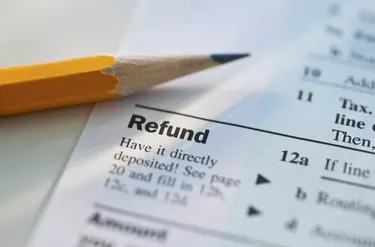
Tax season is here, which means it's time to start gathering documents and filling out forms. If you're expecting a tax refund this year, you may be wondering if the pandemic-related delays of the past couple of years will impact your return this year, as well. Although the Internal Revenue Service is predicting the usual 21-day refund turnaround for most taxpayers, the agency has acknowledged some factors that might slow things down.
IRS Processing Timeline
Video of the Day
Like last year, 2022 brings some challenges as tax season begins. First, there's a tax return processing backlog, with employees still processing responses to notices from last year's returns. Despite that, the IRS estimates a 2022 refund processing time of 21 days for e-filers.
Video of the Day
While saying that, though, the IRS stressed the importance of filing early, making sure there are no errors on your return and setting up direct deposit. The agency has been grappling with staffing shortages in recent years, and those shortages are in addition to the unspecified "ongoing challenges" brought by the coronavirus.
Speeding Up Tax Refund Turnaround
There are some things you can do now to get your refund more quickly. The first thing is to start early. The IRS has already started processing tax returns, so if you have all your W-2 forms, file your return as soon as possible.
Whether you use a tax preparer or do things on your own, it's more important than ever to double-check your return to make sure everything's accurate. Refund delays are often simply because the IRS has to reach out for clarification or request a form you missed.
As always, filing electronically will speed up your refund. Paper returns take six to eight weeks to process, versus 21 days with e-filed returns. Setting up direct deposit will land your return in your bank account faster and more reliably than waiting around for a paper check.
Consider also: Check Out These Tax Tips Direct From the IRS
There's one exception to the 21-day timeline for e-filers. If you're claiming either the earned income tax credit or the child tax credit, the wait to get your money will be even longer. The IRS builds in extra processing time to prevent fraud, so you'll need to factor in some extra wait time.
If you received any economic impact payments or advance child tax credit payments in 2021, the IRS urges you to be extra diligent about double-checking those numbers before you file. You can verify the amount of all 2021 payments on your online IRS.gov account, but you'll also receive a letter from the IRS confirming the amount. If those numbers are off, the IRS will have to take extra time to investigate, further slowing down your refund.
Checking Tax Refund Status
Once you've completed your tax filing, the wait begins. During tax filing season, the IRS directs all taxpayers to the Where's My Refund? page at IRS.gov. To check your refund status, you'll need your Social Security number, filing status and the exact dollar amount you're due.
Information on your status will be available 24 hours after you've e-filed or four weeks after mailing a paper return. Your refund should appear in your bank account soon after the IRS processes it, but that depends on your own bank's processing times.
As in previous years, processing delays will likely be a part of the 2022 tax season. You can speed things up by making sure your return is correct before you send it, using e-file and setting up direct deposit for your refund. Filing as early as possible will also help you get ahead of the rush and possibly ensure your return is processed before any bottlenecks hit.
- IRS.gov: IRS Operations During COVID-19: Mission-Critical Functions Continue
- IRS.gov: IRS Begins 2022 Tax Season; Urges Extra Caution for Taxpayers to File Accurate Tax Returns Electronically To Speed Refunds, Avoid Delays
- IRS.gov: IRS Tax Tip 2001-48 Refunds -- How Long Should They Take?
- IRS.gov: Your Online Account
- IRS.gov: Where's My Refund?
- IRS.gov: About "Where's My Refund?"
- Government Executive: IRS Staffing Shortages Likely to Cause Turbulent Tax Season, Treasury Officials Say